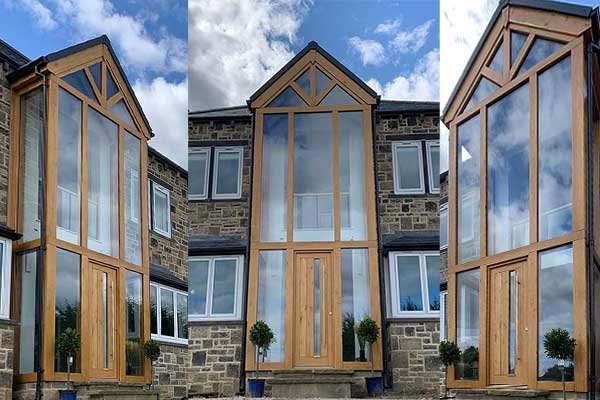
oakbydesign
01423 593 794


Ben contacted Oak By Design, via their website, in January.
Together with his wife Lindsay, they had recently bought a detached house. It was in a quiet cul-de-sac near the exclusive Tranmere Park conservation area in Guiseley. Guiseley is a thriving town on the outskirts of Leeds, and on the edge of the Yorkshire Dales.
They were ready to start renovating the home they had bought just over a year ago with the idea of modernising and bringing the dated home up to date.
Located at the end of a cul-de-sac, but in an elevated position, they wanted to make the most of the views from the front of the house. The house as it was, didn’t benefit from the views once inside though.
The house had a stone entrance built forward of the house with white wrought iron detail in the door and side lights. It wasn’t the look they were aiming for! See below for the "before" photo's.
Instead, the Creswick’s wanted a “Statement timber front feature” that would make the most of the views. It also needed to let light into the front of the house, into the hallway and the upstairs landing area. They sent drawings of their initial proposed ideas, and photos of homes they’d seen with similar ideas of what they had in mind.
After looking at the Oak By Design website, at their Buildings Section, they initially emailed us. Then, after speaking on the phone with Jamie, the couple invited Jamie to visit their home and to see if his thoughts and ideas complemented theirs.
Jamie and the couple discussed their ideas and options. They decided on a 2 storey oak atrium with entrance door that would sit on the front of the home, instead of the dated single storey one.
A couple of steps would lead up to an oak door with a modern, slim, full glazed panel and over-sized pull handle in stainless steel. Full length glazed side lights would sit either side of the door. The door would lead into the hallway which would be open to the first floor.
3 full storey height glazed units above would provide light into the landing area. A balustrade would be set back providing views through the 2 storey glazed units.
The glazed truss was designed with a king post and 2 diagonal braces creating a contemporary feel.
The oak atrium would be approx. 3m wide x 1.4m deep x 6.7m overall.
Once the quotation had been sent, the couple were keen to start the process.
With other building works ongoing the oak atrium was booked into the production calendar to ensure it fit in with these.
Having a full design, manufacture and installation service from us for the oak atrium, gave Ben and Lindsay peace of mind that they could let the team manage the whole process.
The couple chose to have the atrium finished in Osmo Polyx UV oil - in the 420 finish
The atrium was finished a couple of months later and our installation team team installed the atrium. The oak fascia at the top of the atrium was finished off with “2022” engraving! We spoke to Ben and Lindsay a few weeks afterwards to see what a difference the 2-storey atrium had made.
They said the main benefits were:
That there is now much more light upstairs on the landing. Previously it was very dark.
Having the oak atrium at the front of the house has provided such a fabulous and welcoming space to the home. It has certainly provided the “Statement Timber Front Feature” requested!
The house now looks modern and although a period home, it has a contemporary feel to it.
The main benefit is the light, and the views which can now be appreciated from the house.
Ben provided a fabulous review of the oak atrium on Facebook which we hope sums up the process perfectly!
“We were looking to have a bespoke glass and oak atrium for the front of our new home renovation. We wanted to find a company we trusted, who clearly understood our brief and who could manufacture and install a high-quality product at a competitive price. A big ask, butOak By Design ticked all our boxes.
“Jamie and the team, from the initial discovery meeting, to completion of the oak atrium installation, were fantastic. The design, material quality and installation were first class and I would highly recommend you to include them within your project plans. Thank you all”
Oak conservatories have become increasingly popular in modern architecture due to their unique combination of elegance and functionality. The use of oak as a building material brings numerous benefits that contribute to the overall appeal and durability of these structures.
One key advantage is the aesthetic appeal that oak conservatories offer. The rich, warm tones and natural grain patterns of oak create a timeless charm that adds a touch of sophistication to any property. This classic elegance effortlessly complements both traditional and contemporary architectural styles, making oak conservatories a versatile choice for homeowners.
In addition to its visual appeal, oak is also an incredibly durable material. It possesses high levels of strength and resilience, allowing it to withstand harsh weather conditions and resist decay. This longevity ensures that oak conservatories can provide lasting enjoyment for decades without significant maintenance or repair requirements.
Furthermore, oak has excellent insulating properties, which contributes to energy efficiency within the conservatory. By minimizing heat loss during colder months and reducing solar gain in warmer seasons, oak helps regulate temperature inside the structure while reducing reliance on artificial heating or cooling systems.
The versatility, durability, and energy efficiency offered by oak conservatories make them an ideal addition to modern architecture. Their ability to seamlessly blend with different design styles enhances the overall aesthetics of any property while providing long-term value for homeowners.
Green oak and air-dried oak are two distinct types of timber that differ in their characteristics. Understanding these differences is crucial for anyone involved in the construction or woodworking industry.
When comparing green oak to air-dried oak, one can draw an analogy with the concept of ageing wine. Just as wine needs time to mature and develop its unique flavors, green oak requires a seasoning process to achieve optimal quality.
During the seasoning process, green oak gradually loses moisture content through natural drying methods. This reduction in moisture not only improves the stability of the wood but also prevents excessive movement and shrinkage over time. It is comparable to how ageing wine develops complexity while maintaining stability.
On the other hand, air-dried oak undergoes a different drying method. Once cut into sizeable timber pieces, it is left outside to dry naturally over an extended period. The exposure to open air allows for gradual moisture loss through evaporation, resulting in lower moisture content compared to green oak.
The metaphorical comparison between green oak and aging wine helps illustrate how both processes require patience and time for desirable outcomes. Just as aged wine showcases its refined qualities after years of maturing, air-dried oak represents a stable and reliable material due to its prolonged seasoning period.
In summary, understanding the distinction between green oak and air-dried oak is essential when choosing timber for construction purposes. Whether opting for freshly felled or naturally dried wood, each has its advantages based on specific project requirements and desired characteristics.
Double glazing, a window construction technique featuring two panes of glass separated by an insulating air gap, offers numerous advantages for buildings. This article aims to explore the benefits of double glazing in terms of thermal insulation and energy efficiency.
The primary advantage of double glazing lies in its ability to provide enhanced thermal insulation. By incorporating two sheets of glass with a spacer bar filled with insulating gas between them, double glazed sealed units (DGUs) effectively reduce heat transfer through windows. This configuration acts as a barrier, preventing heat from escaping the room while inhibiting the infiltration of cold air from outside.
The use of this innovative window design allows buildings to maintain comfortable indoor temperatures regardless of external weather conditions. During colder seasons, double glazing minimizes heat loss through windows, reducing the need for excessive heating and ultimately lowering energy consumption. Consequently, this contributes to enhanced energy efficiency within buildings.
Moreover, double glazed windows also offer substantial sound insulation properties. The additional layer created by the second pane significantly reduces noise transmission from outdoor sources into interior spaces. This feature is particularly beneficial for urban areas or locations near busy roads where noise pollution can adversely impact occupant comfort and well-being.
In summary, the utilisation of double glazing in building construction provides significant advantages such as improved thermal insulation and reduced noise transmission. These features play a crucial role in creating energy-efficient environments while ensuring optimal comfort for occupants throughout the year.
Telephone: 01423 593 794
Locksley Park
Blind Lane
Tockwith
YORK YO26 7QJ
Opening Times:
Mon to Fri - 9.00am to 5.00pm
Bank Holidays - Closed
Christmas 2025- TBC
Oak By Design is the trading name of:
Oak By Design Ltd.
Reg Number: 04384416
VAT Number: 664 8012 33